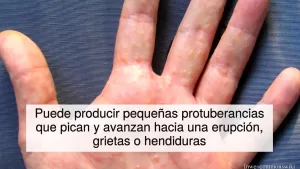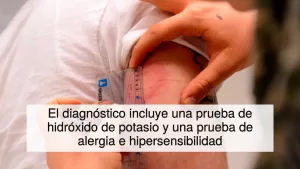Dyshidrotic eczema is one of those conditions that many people are unaware of until they experience it firsthand. It manifests as small blisters that appear on the hands, fingers, or feet, causing intense itching, redness, and even pain when the lesions rupture. Although it’s not life-threatening, it can affect daily life, limiting simple tasks such as washing hands, wearing closed-toe shoes, or handling objects.
The curious thing is that, despite available medical treatments, there is one factor that often goes unnoticed and plays a significant role in the appearance of flare-ups: stress. Although we sometimes underestimate it, emotional and mental stress can be a direct trigger for this type of eczema.

IMPORTANT: You’ll find the video related to this story at the end of the article.
What is dyshidrotic eczema?
This type of dermatitis is characterized by the formation of tiny, fluid-filled vesicles, resembling small water blisters. They usually appear on the palms of the hands, between the fingers, or on the soles of the feet. The itching can be so bothersome that it prevents sleep, and scratching causes the skin to crack, become inflamed, and can even become infected. Although all its causes are not yet known, specialists have identified factors that increase the risk: allergies, contact with certain metals such as nickel, changes in climate, and, of course, high stress levels.
Stress as a Silent Trigger
We’ve all experienced moments of tension that leave us feeling exhausted, but when stress becomes chronic, the body begins to manifest it in different ways. In the case of dyshidrotic eczema, the immune system is altered and responds exaggeratedly, triggering flare-ups. That’s why many people notice that their symptoms worsen during times of work pressure, family conflicts, or strong emotional situations.

How to Manage Stress to Improve Your Skin
While stress can’t always be completely eliminated from life, you can learn to better manage it. Strategies such as meditation, yoga, taking walks outdoors, or simply taking a few minutes of deep breaths a day can make a difference. It’s also key to maintain restful sleep routines, dedicate time to activities that generate pleasure, and, above all, learn to set limits when the daily workload becomes excessive.
Practical care to reduce outbreaks
In addition to managing stress, there are simple measures that help keep your skin under control:

- Use emollient creams to constantly moisturize your hands and feet.
- Avoid harsh soaps and prefer mild, fragrance-free products.
- Protect yourself with cotton gloves under your cleaning gloves if handling detergents or chemicals.
- Keep nails short to avoid more serious injuries from scratching.
- Seek medical help when outbreaks are frequent or painful, as there are topical and oral treatments that can relieve symptoms.

The Vicious Cycle Between Skin and Emotions
One of the most difficult aspects of this condition is that it creates a vicious cycle. Stress triggers breakouts, breakouts generate discomfort and embarrassment, and this in turn causes more stress. Breaking this cycle requires both physical skin care and attention to emotional health. It’s not just about treating the blisters, but about looking at the problem holistically.
Health insurance
An important reminder
: If you suffer from dyshidrotic eczema, don’t blame yourself or think it’s something rare or unique to you. Many people suffer from it, and with the right combination of medical care and stress management, it’s possible to lead a much calmer life with fewer flare-ups. The key is to not ignore the symptoms and learn to listen to your body: when your skin speaks, it’s usually because there’s something else going on that needs attention.